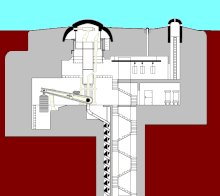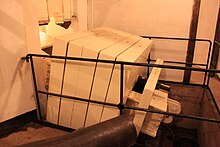Tourelle Galopin de 155 mm R modèle 1907

The Tourelle Galopin de 155 mm R modèle 1907 (Galopin armored turret 155 mm model R 1907) was one of the types of turrets that were built into the forts of the Barrière de fer system created by Séré de Rivières . There is a retractable and 360 ° rotating tower in a gun fountain of concrete is installed. A steel armor is placed on the edge of the gun well . The gun consists of a 155 mm type R cannon (R stands for "raccourci à tir rapide" and means "shortened - rapid fire")
history
The "Tourelle Galopin" was developed in 1889 by Commandant Alfred Galopin as a result of the experiments (1887–1888) in the "Camp de Châlons" with the "Tourelle Bussière". This was a retractable tank turret with a 40 cm thick steel dome, equipped with two Canon de 155 L de Bange cannons . The dome was 5.5 meters in diameter. The total weight was 200 tons, 150 tons of which was accounted for by the moving parts, including the 80-ton fire stand, consisting of the guns, the lifting mechanism and the gun platform.
In 1903 the technical section of the pioneers proposed a turret for introduction, which was based on the "Tourelle Bussière", but was equipped with only one gun. It should be equipped with a new cannon, the "Canon de 155 raccourci à tir rapide" (shortened rapid fire cannon 155 mm). Two projects were presented, each with one and two cannons. This was followed by a heated debate about the pros and cons, which lasted until 1905, when the decision was made in favor of the tower with a cannon. The approval of the army leadership took until 1907.
description
The cost of the armor parts was 537,500 Francs d'or , which was a little lower than the larger version with two guns. The maximum range of the cannon was (due to the short tube) at 7200 meters. The dome had a ceiling thickness of 30 centimeters, the weight of the moving parts was 120 tons, the counterweights weighed 70 tons. The elevation range of the cannon was between −2 ° and + 22 °.
The manufacturer was the Schneider company
The functional principle was based on Galopin's suggestions, even if some had been modified. The sophisticated mechanics of the lifting device made it possible to retract the turret every time a shell was fired . (Without this system, the tower, the effort and to be able to maintain the rate of fire , would have had to remain extended for a certain period of time.) The complete process: extending, firing, retracting only took 4 to 5 seconds in the best case.
The system is housed in a concrete shaft and extends over three floors.
- The manual drive system for rotating the tower is located on the lower floor. Two cranks acting through a gearbox on slewing. Each crank was operated by two men. A complete revolution was possible in 60 seconds. The counterweights and a reserve gun barrel are also located here. From here the ammunition was carried up by an elevator. Up to 3000 shells could be stored in the associated ammunition magazine.
- In the middle floor there was the system for the lateral direction with a terrain disc, as well as the device for fine adjustment of the cannon (fine adjustment of the lateral direction). Here 50 ready-to-use ammunition shells could be stored in wall niches.
- The fire stand with the 155 R cannon, the leveling machine and the controls for raising and lowering the tower was on the upper floor.
Of these towers, 13 were made, but only 12 were installed. A further 24 towers were planned, but could no longer be built due to the outbreak of the First World War . Eight of the existing towers were dismantled by the German armed forces during the Second World War and scrapped. Today only the tower of Fort d'Uxegney is in working order after it was extensively restored by the Association ARFUPE (Association pour la Restauration du Fort d'Uxegney et de la Place d'Epinal).
The other three remaining: Fort Douaumont , Fort de Rozelier and Fort de Moulainville of the Verdun Fortress are without function. You are in a deplorable condition today.
In Fort de Vacherauville , the towers were blown up in 1944 by the Todt Organization and scrapped for steel production. For unknown reasons, this did not happen completely, so there are still massive remains on the fort's site.
variant
The twin turret with two guns Tourelle de 75 mm R modèle 1905 existed in a similar version . This was used in higher numbers.
literature
- Nathalie Wagner "La tourelle Galopin" Lycée Aline Mayrisch - Institut Pierre Werner Luxembourg



